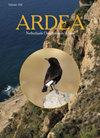群落繁殖者的恐惧生态学:地面筑巢大鸬鹚的群落结构反映了捕食者的存在
IF 1.3
4区 生物学
Q3 ORNITHOLOGY
引用次数: 3
摘要
在荷兰伊泽尔梅尔湖附近的三个殖民地,对地面筑巢的大Cormorants进行了监测。利用繁殖高峰期拍摄的航空照片,确定了连续四年的巢穴密度和最近邻居距离。此外,还确定了捕食者的种类和数量。总共有五种哺乳动物和九种鸟类捕食性物种与Cormorant繁殖地有关。巢的空间分布主要表现为分散型和随机型,而非传染性。后一种分布,巢穴之间的距离比随机和均匀分布模式下的预期要小,2013年在De Ven殖民地发现,也就是它存在的最后一年。食肉动物赤狐Vulpes Vulpes于2010年抵达该殖民地。在所有三个群落中,捕食者数量最多的群落中,巢穴密度最高,最近邻距离最短。在低到中等的捕食压力下,地面筑巢的Cormorants在巢穴之间留下了自由空间,供成年鸟类在起飞和降落时使用。在它存在的最后几年里,不断缩小的De Ven群落呈现出几乎圆形的形状,巢穴密度极高,边缘与表面积之比最低。但由于狐狸的存在,在边缘繁殖仍然由于直接捕食造成了更大的损失。繁殖成功率在群落之间同步波动,但在捕食者数量较多的群落中较低。红狐狸的到来造成了幼狐狸的极度损失,多年来,繁殖者的数量急剧下降,最终导致2014年该地完全废弃。大型海鸥形成了另一个重要的捕食者群体,但并没有导致Cormorants放弃繁殖地。在Vooroever殖民地,灌木和树木覆盖提供了庇护所,使鸟类能够在更大的密度下繁殖,而不会导致最近邻居的密度降低,就像没有覆盖时的情况一样。更大的巢穴密度和减少最近邻距离被认为是鸟类个体对捕食者存在的积极反应。当捕食者数量增加时,通常在中等密度环境下存在的群落内空地上就会布满巢穴,几乎没有或根本没有降落和离开的空间。这会减少边缘效应和群体的圆形,从而潜在地限制捕食风险。由于巢密度极高,繁殖成功率较低,这是由于受到其他Cormorant的干扰。这项研究首次表明,水鸟的群落结构受到捕食者驱动的创始鸟类之间的吸引力和排斥力的影响。本文章由计算机程序翻译,如有差异,请以英文原文为准。
Ecology of Fear in a Colonial Breeder: Colony Structure in Ground-Nesting Great Cormorants Phalacrocorax carbo Reflects Presence of Predators
Ground-nesting Great Cormorants were monitored in three neighbouring colonies at Lake IJsselmeer, The Netherlands. Using aerial photographs taken during peak breeding time, nest density and nearest neighbour distance were determined for four sequential years. In addition, species and number of predators were determined. In total, five mammalian and nine avian predatory species were associated with the Cormorant breeding colonies. Spatial distribution of nests mostly showed dispersed and random patterns rather than a contagious pattern. The latter distribution, with less distance between nests than expected both from a random and equal distribution pattern, was found in the colony of De Ven in 2013 during the last year of its existence. The predator Red Fox Vulpes vulpes arrived at the colony in 2010. In all three colonies, nest density was highest and nearest neighbour distance shortest in colonies with the highest number of predators. At low to moderate predatory pressure, ground-nesting Cormorants left free space between nests that was used by adult birds during take-off and landing. During the last years of its existence the shrinking colony of De Ven showed an almost circular shape, with an extreme nest density and the lowest edge-to-surface area ratio. But with Foxes present, breeding at the fringe still caused greater losses due to direct predation. Breeding success fluctuated synchronously between colonies but was lower in colonies where the number of predators was higher. The arrival of Red Foxes in De Ven caused extreme losses of young and over the years resulted in a strong decline in number of breeders, eventually leading to complete abandoning of the site in 2014. Large gulls formed another important group of predators but did not cause the Cormorants to abandon the breeding site. In the Vooroever colony, bush and tree cover supplied shelter and allowed birds to breed in greater density without causing nearest neighbour density to decrease, as was the case when no cover was available. Greater nest density and reduced nearest neighbour distances are considered to be a pro-active response by individual birds to the presence of predators. When predator numbers increased, the within-colony open spaces that normally exist under circumstances of moderate density were filled up with nests, leaving little or no room for landing and departure. This leads to reduced edge effects and a circular shape of the colony, thereby potentially limiting predation risk. As a consequence of extreme high nest densities, breeding success was lower due to interference by other Cormorants. This study is the first to show that colony structure in waterbirds is affected by forces of attraction and repulsion between founding birds that are predator driven.
求助全文
通过发布文献求助,成功后即可免费获取论文全文。
去求助
来源期刊

Ardea
生物-鸟类学
CiteScore
2.10
自引率
0.00%
发文量
49
审稿时长
>12 weeks
期刊介绍:
Ardea is the scientific journal of the Netherlands Ornithologists'' Union, and is published since 1912. The journal welcomes manuscripts reporting significant new findings in ornithology, in particular those covering the ecology, life history, and evolution of birds, and including sound descriptive work. Ardea publishes Original research papers, Short notes and Book reviews. In addition to the regular three issues per year, Ardea publishes specials that contain conference or workshop proceedings (produced on request).
 求助内容:
求助内容: 应助结果提醒方式:
应助结果提醒方式:


